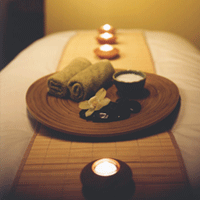How are spas — with their aura of perceived luxury — faring in this gloomy economy?
In times of economic uncertainty, when consumers and businesses both feel the squeeze, stress levels seem to rise as stock prices fall. And, just when spas and their stress-managing benefits are most needed by the working public, such perceived luxury items are typically the first things to go. For many hoteliers, that’s meant working harder, working smarter and re-thinking marketing and operational strategies to keep their spas profitable.
“We started seeing a dip in occupancy last October,” says Paul Macintyre, general manager of the 122-room Pillar and Post and executive liaison of the three Vintage Hotels spas in the Niagara and Caledon regions of Ontario. The dip was mostly corporate and, “spa was definitely the first thing to go.”
Nevertheless, Macintyre says it’s been “an exciting year for our spas.” At a time when many across the country are showing a decline, the 100 Fountain Spa at Pillar and Post and the Secret Garden Spa at the Prince of Wales Hotel stay afloat thanks to a reengineered operating philosophy. Both hotels are located in Niagara-on-the-Lake, Ont., and by concentrating efforts on leisure guests — 60 per cent of which live within a 2.5-hour drive and stay for shorter periods and book more at the last minute — Macintyre and his team are driving more business into the spas.
Dennis Smith, general manager of the 117-room Inn at the Forks in Winnipeg, says his hotel has been fairly isolated from the economic downturn. Despite the recession, the hotel’s corporate base (small groups of 20 to 60 people) has remained constant and summer leisure business, most of it local, was off slightly. Business has not only been stable, he says, but “it grew a bit in the first half of the year, due to a gift-card program and the stability of room business.”
The spa continues to draw local day guests and a larger number of in-house guests on weekends, with many driven to book by packages that concentrate on good value and price-point sensitivity. Smith says he doesn’t like straight discounts but prefers added value — a room upgrade, for instance, or an addition to a spa treatment. He’s also using the added-value model to help migrate spa business to slower weekday periods. He says the spa industry is still relatively new in Winnipeg, but appreciation is growing as consumers accept it as part of a healthy lifestyle.
For other spas across the country, the picture hasn’t been as rosy. Pat Corbett, veteran industry observer, advisor and owner of Hills Health Ranch in the interior of B.C., says consumer demand for the spa product has not kept pace with growth in supply. That, plus the economic environment, “has really impacted the market,” and it has been reflected in his resort’s occupancy rate since as early as summer 2008. The trend, “deepened and hardened over the fall and winter,” says Corbett, and the resulting lower occupancy, shorter stays and a drop in overall spend at the health-focused resort has forced cutbacks on basic staffing and general operations. But he concedes it’s part of the business cycle and he’s beginning to sense early signs of a recovery with the trickling return of American guests. While adjusting operationally, Corbett is still bullish about the industry. He’s moving ahead with the addition of a $100-million spa village that‘s now in its final planning stages.
At the 57-room Old Mill Inn & Spa in Toronto, general manager Vincent Cotte says corporate bookings — which represent about 35 per cent of overall business at the Inn — are down about 20 per cent. Business from leisure guests, mainly locals on special-occasion visits, has “stayed steady.” Overall, revenues at the Inn’s owned and operated spa, which was expanded last year to allow for small corporate groups and wedding parties, is also down about 20 per cent.
Spa director Christina McDougall says 90 per cent of spa business at the Old Mill is local and confirms there’s been a downturn in the number of bookings. For instance, she says that instead of booking six facials over the course of the year, clients are now booking four. But one of the things they’re not giving up, points out McDougall, is buying product. Consequently, the economic hit on her retail revenue has been slight.
Louise Brossoit, vice-president and general manager of Amerispa’s nine outlets in Quebec, says her retail business has grown across the board and her overall annual revenue is up slightly, due, in part, to a gift-certificate program and the fact that guests are buying more upgraded services. Brossoit can’t pinpoint the exact reason for the upgrades, but guests who are continuing to visit spas are spending more on treatments and product.
Nevertheless, some spas in the Amerispa collection have fared better than others. At the Château Bonne Entente in Quebec City, director Alain April admits, “It’s been a tough year,” although his spa enjoyed 13-per-cent growth over the May-to-August period, largely due to local clientele. In spas located in resort areas such as Mont Tremblant, where business depends primarily on the in-house market, growth has been tempered.
Working Smarter, More Creatively
Paul Verciglio, general manager at the Toronto Park Hyatt, says while room business is down “the spa hasn’t nearly been as affected because 95 per cent of our spa business is local.” But he does admit that his team works a lot harder to keep the revenues with which they’re accustomed. Verciglio says the hotel’s Stillwater Spa stays “in front” of customers with different monthly promotions such as a $150 spa sampler package, which offers clients a choice of three out of four 30-minute treatments. “It’s been very popular,” he says. “It helps drive business into the slower Monday to Thursday periods.”
One of the Old Mill’s strategies for its spa has been to increase the average spend by concentrating on existing clientele. For instance, McDougall says her staff is more proactive when taking bookings — suggesting add-ons such as a facial or pedicure with a massage — and giving departing clients incentives to re-book at the Mill. And to drive the local “girlfriend” market, the hotel even introduced an $89 day package, including lunch, a glass of champagne and a treatment.
Whatever promotion you’re running, effective marketing relies on building partnerships and coming up with new ideas to capture attention, says Cotte. To raise awareness, he’s working with community partners such as a wine company, providing education on wine/food pairings at strategic LCBO locations.
New Media Versus Traditional
For many, capturing attention means embracing the digital world. Email blasts and direct mail campaigns continue to carve a wider niche for marketing departments reaching out to existing clients. “Direct marketing through email continues to be the most cost-effective way to distribute the message,” says Verciglio. But coming on strong are social media networks, which are gaining a larger place as digital distribution channels continue to nudge out mainstream print.
In addition to email blasts, Inn on the Fork’s Smith says they post daily specials and V.I.P. program updates on Twitter and Facebook. At Hills Health Ranch, Corbett not only relies heavily on email blasts but he has produced a video for YouTube and added a social media specialist to his staff.
When it comes to the more traditional forms of advertising, Smith is still active. He buys radio spots strategically to promote gift certificates and overnight packages to the local market. And to maximize the hotel’s location in the busy, historic Forks district of Winnipeg, he’s added an outdoor LCD billboard to spread word about the holiday gift-certificate program and drive traffic to the special-purchase kiosk that’s set-up at the front entrance.
In an effort to attract new clients, Corbett continues to patronize consumer shows within close-range markets. “It’s more personal,” he says, “and at this time there’s less and less of it.” Over a two-month period this past fall, he hit eight consumer shows in his home province of B.C., but working with media for editorial coverage remains a key driver as well.
Last But Not Least
Traditionally, hotel guests have been encouraged to reserve spa time when making a guest-room reservation, but Macintyre says that practice is changing. At the three Vintage Hotel spas, the operating philosophy has shifted — they’re focusing more on in-house guests that haven’t already booked. Approximately 35 per cent of spa business now comes from in-house and, “everything is last minute, even groups.” He admits spas need to be more flexible and improve on areas like forecasting and lost calls. And operators absolutely should be ready for guests and last-minute bookings because, “last-minute is the new guest behaviour.”
A handful of the other spa managers interviewed are also seeing an increase in last-minute bookings, but it’s not happening across the industry. At the Inn on the Forks, for instance, lead time for weekend spa business is still about three weeks in advance.
When it comes to other spa trends, Wanda Love, CEO at Leading Spas of Canada, says the recession has led to a greater focus on core treatments, the growing attention paid to health and wellness and an increased focus on “at home care,” which is possibly accounting for some of the surge in retail.
Couples massages continue to be the number 1 revenue generator at most spas where the duo treatment is offered. Demand has been so brisk at the Inn on the Forks, Smith says the hotel has introduced a dedicated reservation service to handle the bulk of couples massage/room packages. They’re also phasing in a couples’ suite program where guests can book a two-and-a-half-hour mini-spa experience in a special hotel suite. The introduction of the guest-room spa suite has opened the couple’s treatment room to other services to help build weekend business.
Like everything else in this face-paced world, the spa industry is evolving. According to Corbett, increased competition plus the economic environment has led to a new “industry reality.” It’s no longer business as usual.
“Business has changed,” says Macintyre, “but it is still there — if you know where to look.”




















